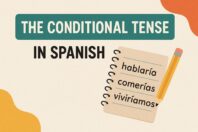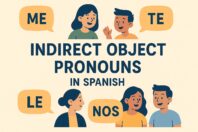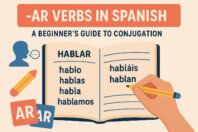Present Perfect Spanish: Explained Like You’re Five Years Old

Get our free email course, Shortcut to Conversational.
Have conversations faster, understand people when they speak fast, and other tested tips to learn faster.
More infoIt’s easy to be overwhelmed by complex grammar terminology when you first start learning Spanish.
So what exactly do we mean by the present perfect Spanish tense (or “pretérito perfecto” en español)?
The name present perfect is a little confusing as it’s not clear whether the tense is related to the past, or the present.
The truth is that it’s related to both.
As with its English counterpart, this tense is used when describing an action that started and finished in the past, but happened in a recent enough time frame that it is connected to the present.
The easiest way to break this down in simple terms is by reviewing the same tense in English, which uses a simple formula:
Auxiliary verb “to have” + past participle of the main verb.
- I have (I’ve) eaten
- We have (We’ve) drunk
- They have (They’ve) visited
In Spanish, the formula is exactly the same:
Auxiliary verb “haber” + past participle of the main verb.
- Yo he comido – I’ve eaten
- Nosotros hemos bebido – We’ve drunk
- Ellos han visitado – They’ve visited
TIP: You can use this tense as a “hack” to speak about the past in Spanish, before actually learning correct past tense grammar (of course, sometimes it won’t sound technically correct, but people will still understand you).
Now that you know what this tense is, we can examine how to conjugate it.
In order to use this tense correctly, you need to learn the conjugation for the auxiliary verb “haber”, which is as follows:
Personal pronoun |
Haber (Present Perfect) |
| Yo | He |
| Tú | Has |
| Él / Ella | Ha |
| Usted | Ha |
| Nosotros | Hemos |
| Ustedes / Vosotros (Spain) | Han / Habéis (Spain) |
| Ellos / Ellas | Han |
The above conjugation will not change.
Once you know it, all you need to do is add the past participle of the main verb you want to use, and bingo, you’re speaking in present perfect Spanish.
For example:
- Yo he + comido (Comer) en el restaurante – I’ve eaten at the restaurant
- Nosotros hemos + tomado (Tomar) cerveza – We’ve drunk beer

Unsure what to learn next?
Download the exact curriculum that thousands of BaseLang students have used to become fluent in Spanish.
Download Guide Now!
How To Add The Past Participle
All regular verbs follow a structure which consists of taking the root of the verb and changing the ending, depending on whether the verb ends in AR, ER or IR.
(as always, there are irregular verbs we need to deal with, but we’ll come to those later)
AR Verbs
Regular verbs ending in -AR will add the ending “-ado” to the root of the verb.
For example, the verb comprar (to buy) will become “comprado” (bought).
- Nos hemos comprado un nuevo auto – We have bought a new car
- Él ha cocinado toda la noche – He has cooked all night
- No has comprado el boleto – You haven’t bought the ticket
ER & IR Verbs
Regular verbs ending in both -ER and -IR will add the same ending “-ido” to the root of the verb.
For example, the verb comer (to eat) will become “comido” (eaten), and the verb dormir (to sleep) will become “dormido” (slept)
- El ha comido mucho hoy – He has eaten a lot today
- Ellos han vendido a la casa – They’ve sold the house
- Hemos dormido todo el día durante el vuelo – We’ve slept the entire day during the flight
Commonly Used Verbs In Present Perfect Tense
Once you know how to conjugate the auxiliary verb Haber, it’s easy to use the present perfect tense when dealing with regular verbs.
Simply add the respective -ADO and – IDO endings.
Common Regular Verbs |
Past Participle |
| Bailar | Bailado |
| Cantar | Cantado |
| Estudiar | Estudiado |
| Trabajar | Trabajado |
| Entrar | Entrado |
| Caminar | Caminado |
| Jugar | Jugado |
| Dormir | Dormido |
| Nacer | Nacido |
| Conducir | Conducido |
| Sentir | Sentido |
We Need To Talk About Present Perfect Spanish Irregulars
Up until now, using present perfect Spanish with regular verbs has been easy.
But of course, there are irregular verbs that we need to deal with and these verbs do not follow the -ado or -ido rule we previously covered.
Each irregular verb has a different past participle, which you need to memorize separately.
Let’s dive in and look at the most common irregular verbs.
Irregular verb |
Past participle |
Haber + Past participle |
English |
| Decir | Dicho | Has dicho la verdad | You’ve said the truth |
| Ver | Visto | He visto la película | I’ve watched the move |
| Poner | Puesto | Hemos puesto la comida en la mesa | We’ve put the food on the table |
| Ser | Sido | He sido un buen amigo | I’ve been a good friend |
| Hacer | Hecho | Ellos han hecho la cena esta noche | They’ve made the dinner tonight |
| Morir | Muerto | Las flores han muerto | The flowers have died |
| Abrir | Abierto | Hemos abierto las puertas de la iglesia | We’ve opened the doors of the church |
| Escribir | Escrito | Mi amigo me ha escrito un mensaje de texto | My friend has written a text message to me |
| Ir | Ido | Hemos ido a Japón muchas veces | We’ve gone to Japan several times |
| Volver | Vuelto | Hemos vuelto de nuestro viaje | We’ve returned from our trip |
| Romper | Roto | ¿Han roto los platos? | Have they broken the plates? |
| Suscribir | Suscrito | ¿Te has suscrito a mi canal? | Have you subscribed to my channel? |
| Devolver | Devuelto | Han devuelto los boletos de avión. | They’ve returned the flight tickets. |
| Cubrir | Cubierto | Hemos cubierto la mesa con tela negra. | We’ve covered the table with black fabric. |
| Resolver | Resuelto | ¿Quién ha resuelto el problema? | Who has solved the problem? |
| Leer | Leído | He leído todos los libros en una semana | I have read all the books in a week |
Using The Reflexive With Present Perfect Spanish
It’s important to understand how to use reflexive pronouns in the present perfect tense.
Reflexive verbs are used when a subject in a sentence performs an action on itself.
For example, the sentence “I have seen myself in the mirror” requires you to use the reflexive verb + reflexive pronoun, which goes before the haber conjugation.
The result is:
“Yo me he visto en el espejo”.
Notice that the position of the reflexive pronoun “me” is placed between the subject and the conjugated verb “haber”.
Since we can drop personal pronouns in Spanish, we will often find sentences that start with a reflexive pronoun ie. Me he visto en el espejo.
Examples Of Reflexive Verbs In Present Perfect
- Me he comprado un regalo por mi cumpleaños – I have bought myself a birthday gift.
- ¿Te has abierto una cuenta en el banco? – Have you opened (yourself) a bank account?
- Se han ido del restaurante por el mal servicio – They have left the restaurant because of the bad service.
- Nos hemos perdido en el bosque – We’ve lost (ourselves) in the woods.
- Me he puesto mi mejor traje esta noche – I’ve put on my best suit tonight
When To Use Present Perfect Tense
Now that you know how to conjugate and structure sentences in present perfect, we can review how this tense is commonly used.
Firstly, it is used to describe actions that are still happening:
- He vivido en París desde que era un niño – I have lived in Paris since I was a child
It’s also used to describe something that just happened:
- ¡He visto un fantasma! – I have just seen a ghost!
It’s important to mention that this tense is more commonly used in Spain. In Latin America, you will find more people using Simple Past (pretérito indefinido), which is why it is important to explain some of the differences between these two tenses.
Present Perfect v Simple Past
The present perfect tense is more commonly used to describe actions that occurred in a recent past, such as today, this morning or this afternoon.
- He visto a mi profesor de español esta mañana – I’ve seen my Spanish teacher this morning
Even if you don’t mention the timeframe, using present perfect tells us that the action took place not too long ago.
Whereas actions that occurred, for example, yesterday or last week will normally be expressed using the simple past tense.
- Ayer vi a mi profesor de español – I saw my Spanish teacher yesterday
Let’s look at one more example of the differences between both tenses:
- He visitado la ciudad de Barcelona en España – I’ve visited the city of Barcelona in Spain
- Visité la ciudad de Barcelona en España – I visited the city of Barcelona in Spain
At first glance, both sentences look the same.
However, the first sentence tells us that action took place in the past, without mentioning a particular moment in time ie. I’ve visited the city of Barcelona before, which could refer to several visits or just one, for a short or long period of time.
The second sentence tells us that the action only happened once ie. I visited Barcelona at a specific point in time. Even if the time or date is not given, the listener will understand that the action happened once.
General Examples of Present Perfect
- He escuchado música toda la noche – I’ve listened to music all night.
- No hemos visitado a mis abuelos – We have not visited my grandparents.
- Han estado muy contentos últimamente – They have been very happy lately.
- ¿Han visto la última película de Disney? – Have you seen Disney’s last movie?
- Aún no has hecho tu tarea – You haven’t done your homework yet.
- Ella me ha comprado un celular nuevo – She has bought me a new phone.
- ¿No te lo hemos dicho varias veces? – Haven’t we told you that several times?
- Te hemos visto tocar en concierto – We have seen you play in concert.
- Me he roto un hueso – I’ve broken one of my bones.
- Ella se ha comprado una casa nueva – She has bought herself a new house.
Present Perfect Subjunctive Spanish
The last thing that we’re going to cover is using present perfect tense in the subjunctive mood.
The subjunctive for present perfect is used to speak about past actions related to the present, as well as future actions that may or may not be completed.
These actions tend to be:
- Desires
- Expectations
- Opinions
- Probabilities
- Other actions that express uncertainty
You might recall the formula we used earlier for present perfect.
Auxiliary verb “haber” + past participle of the action verb.
The present perfect subjunctive uses almost the same formula, with a slight change.
Instead of using the auxiliary verb “haber” in present tense, we’re going to conjugate it in present subjunctive as follows:
Auxiliary verb “haber” (in its present subjunctive form) + past participle of the action verb.
| Personal pronoun | Haber (Present Subjunctive) |
| Yo | Haya |
| Tú | Hayas |
| Él / Ella | Haya |
| Usted | Haya |
| Nosotros | Hayamos |
| Ustedes / Vosotros (Spain) | Hayan / Hayáis (Spain) |
| Ellos / Ellas | Hayan |
As you can see, the conjugation is slightly different, but we still use the auxiliary verb “haber” and add the past participle of the action verb.
When To Use Present Perfect Subjunctive
As we mentioned earlier, the present perfect subjunctive is normally used when conveying emotions, possibility, feelings, doubts, uncertainty, opinions, desires, and expectations.
These are some common examples:
Opinions (ie. something isn’t a fact)
- No creo que haya sido verdad – I don’t think it has been true
- Dudo que haya viajado tanto – I doubt that he has traveled that much
Things that are likely to happen:
- Es posible que hayan llegado tarde hoy – It is possible that they’ve arrived late today
Wishes and expectations (feelings):
- Espero que hayas tenido un buen día – I hope you’ve had a good day
Next, we will examine how the present perfect subjunctive can be connected both to the past and the future.
(sidenote: this subjunctive tense doesn’t exist in English, which is why some of the sentences don’t translate well. )
Past actions related to the present
Present perfect subjunctive is used whenever we want to speak about an action that was supposed to happen in the past, but we don’t know whether it happened or not, or how it went.
For example:
- Es posible que haya perdido todo mi dinero – It’s possible that I’ve lost all my money
Here we are talking about a possibility. The action happened in the past, but right now, in the present, we don’t know if I’ve lost the money or not – we just guess that it could have happened.
- Es posible que hayan encontrado un buen restaurante – It is possible that they’ve found a good restaurant.
- Espero que el equipo de fútbol haya ganado el partido – I hope that the football team had won the match.
Future actions that may or may not be completed
It can also be used to describe actions that we expect to be finished in the future, but there is a feeling of uncertainty as to whether it will happen or not.
Take a look at these examples:
- Deseo que para el próximo año ya hayamos vendido la casa – I wish that we’ve already sold the house by next year.
- Llama a tu madre cuando hayas terminado la tarea – Call your mother when you’ve finished the homework.
Triggering the subjunctive
There are a couple of easy rules that you can memorize to help you identify when you need to use the subjunctive.
Since the subjunctive is used in relative clauses, it will be preceded by phrases and expressions that indicate a probability, desire, or assumption related to something is not fact (at least not yet), or something that is unknown.
For example,
- Espero que… / I hope…
- No creo que… / I don’t think that…
- Es posible que… / It’s possible that…
- Dudo que… / I doubt that…
You will notice that the relative pronoun “que” is a cue to enter the subjunctive mood.
Examples:
- No creo que haya comido tan temprano – I don’t think that he has eaten so early.
- Es posible que hayas comprado la talla incorrecta – It’s possible that you’ve bought the wrong size.
- Me alegra mucho que hayas venido – I’m so happy that you’ve come.
- Espero que hayamos tomado la decisión correcta – I hope that we’ve taken the right decision.
That’s all!

Unsure what to learn next?
Download the exact curriculum that thousands of BaseLang students have used to become fluent in Spanish.
Download Guide Now!
Exercises
For now, you can test your comprehension with the exercises below.
Fill the blanks with correct conjugation of the verb haber and past participle (present perfect).
(You can find the correct answers below.)
1. (Encontrar)
____________________ el mejor restaurante de la ciudad.
I have found the best restaurant in the city.
2. (Explicar)
El profesor ____________________ el tema nuevo esta mañana.
The teacher has explained the new subject this morning.
3. (Terminar)
Nos quedaremos en casa hasta que la cuarentena ______________.
We will stay at home until the quarantine has ended
4. (Hacer)
Es bueno que _________________ la tarea.
It’s good that you have done your homework.
5. (Correr)
Ellos ____________________ en esta pista muchas veces.
They have run on this track several times.
6. (Tomar)
Es peligroso que _______________ este camino.
It’s dangerous that we have taken this road.
7. (Comprar)
Ella se ______________ un vestido costoso.
She has bought herself an expensive dress.
8. (Ver)
¿Te ________________ en el espejo esta mañana?
Have you seen yourself in the mirror this morning?
9. (Escuchar)
No _________________ escuchado esa banda.
I have not listened to that band.
10. (Estudiar)
Espero que _______________ mucho para la prueba.
I hope they have studied a lot for the test
11. (Terminar)
Podrías jugar una vez que _______________ tu tarea.
You can play once you have finished your homework.
12. (Poner)
Ustedes _________________ las llaves en el lugar equivocado.
You have put the keys on the wrong place.
Answers
- He encontrado el mejor restaurante de la ciudad.
- El profesor ha explicado el tema nuevo esta semana.
- Nos quedaremos en casa hasta que la cuarentena haya terminado.
- Es bueno que hayas hecho tu tarea
- Ellos han corrido en esta pista muchas veces.
- Es peligroso que hayamos tomado este camino.
- Ella se ha comprado un vestido costoso.
- ¿Te has visto en el espejo esta mañana?
- No he escuchado esa banda.
- Espero que hayan estudiado mucho para la prueba.
- Puedes jugar una vez que hayas terminado tu tarea.
- Ustedes han puesto las llaves en el lugar equivocado.


